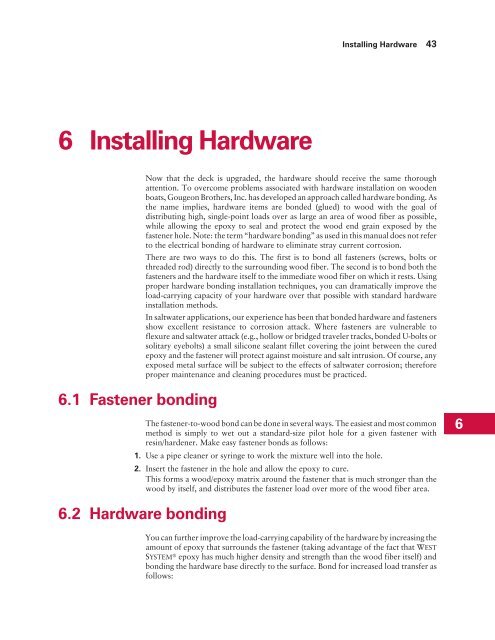Wooden Boat Restoration Repair - WEST SYSTEM Epoxy
Wooden Boat Restoration Repair - WEST SYSTEM Epoxy
Wooden Boat Restoration Repair - WEST SYSTEM Epoxy
Create successful ePaper yourself
Turn your PDF publications into a flip-book with our unique Google optimized e-Paper software.
6 Installing Hardware<br />
6.1 Fastener bonding<br />
Now that the deck is upgraded, the hardware should receive the same thorough<br />
attention. To overcome problems associated with hardware installation on wooden<br />
boats, Gougeon Brothers, Inc. has developed an approach called hardware bonding. As<br />
the name implies, hardware items are bonded (glued) to wood with the goal of<br />
distributing high, single-point loads over as large an area of wood fiber as possible,<br />
while allowing the epoxy to seal and protect the wood end grain exposed by the<br />
fastener hole. Note: the term “hardware bonding” as used in this manual does not refer<br />
to the electrical bonding of hardware to eliminate stray current corrosion.<br />
There are two ways to do this. The first is to bond all fasteners (screws, bolts or<br />
threaded rod) directly to the surrounding wood fiber. The second is to bond both the<br />
fasteners and the hardware itself to the immediate wood fiber on which it rests. Using<br />
proper hardware bonding installation techniques, you can dramatically improve the<br />
load-carrying capacity of your hardware over that possible with standard hardware<br />
installation methods.<br />
In saltwater applications, our experience has been that bonded hardware and fasteners<br />
show excellent resistance to corrosion attack. Where fasteners are vulnerable to<br />
flexure and saltwater attack (e.g., hollow or bridged traveler tracks, bonded U-bolts or<br />
solitary eyebolts) a small silicone sealant fillet covering the joint between the cured<br />
epoxy and the fastener will protect against moisture and salt intrusion. Of course, any<br />
exposed metal surface will be subject to the effects of saltwater corrosion; therefore<br />
proper maintenance and cleaning procedures must be practiced.<br />
The fastener-to-wood bond can be done in several ways. The easiest and most common<br />
method is simply to wet out a standard-size pilot hole for a given fastener with<br />
resin/hardener. Make easy fastener bonds as follows:<br />
1. Use a pipe cleaner or syringe to work the mixture well into the hole.<br />
2. Insert the fastener in the hole and allow the epoxy to cure.<br />
This forms a wood/epoxy matrix around the fastener that is much stronger than the<br />
wood by itself, and distributes the fastener load over more of the wood fiber area.<br />
6.2 Hardware bonding<br />
Installing Hardware 43<br />
You can further improve the load-carrying capability of the hardware by increasing the<br />
amount of epoxy that surrounds the fastener (taking advantage of the fact that <strong>WEST</strong><br />
<strong>SYSTEM</strong> ® epoxy has much higher density and strength than the wood fiber itself) and<br />
bonding the hardware base directly to the surface. Bond for increased load transfer as<br />
follows:<br />
6
















